
John Wesley
Dose of Reality
by Anil Prasad
Copyright © 2015 Anil Prasad.
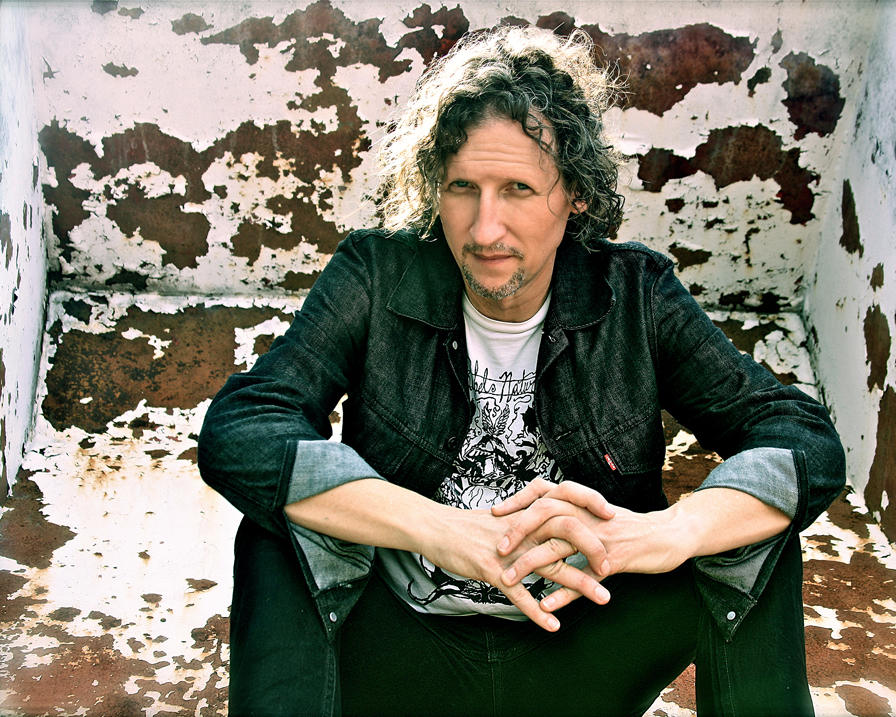
Conflict, disarray and discontent are running themes throughout John Wesley’s Disconnect. The expansive rock effort, infused with dramatic moods, dark textures and soaring vocal harmonies, looks at the challenges of modern life. It deals with fractured relationships, post-war angst, spirituality, greed, and economic survival. It’s deep stuff, tempered with resolution and hope.
Wesley’s virtuoso guitar work shares center stage with the album’s reflective motifs. He invokes a diverse array of sounds, tones and characters from his instruments. And while he’s known for lengthy, exploratory solos as a long-time member of Porcupine Tree’s live band, the entirety of his guitar work on Disconnect is designed to serve the song’s structural and emotional contexts. However, there are plenty of heated, searing guitar moments on the album, including a guest appearance from Rush’s Alex Lifeson. Co-producer Dean Tidey also contributed foundational guitar work to the record and helped guide it so it reflected a balanced sonic perspective.
Outside of his solo career, which includes seven previous studio releases, Wesley has a deeply-established footprint with several other notable rock acts, including Fish, Marillion, Sound of Contact, and Steven Wilson as a solo artist. In fact, much of Wesley’s initial visibility is related to Marillion offering him an opportunity to open for the band in 1992. It set a chain of events and relationships in motion that helped him arrive at the point he’s at today—something explored in this career-spanning conversation.
Disconnect was a long time in the making. Describe the journey it represents.
I’ve been writing songs since the early ‘90s. I kicked that into gear after I left Autodrive, a band I had spent 10 years trying to get a record deal for since the ‘80s. It was stylistically confused. When I got out of that band, I found myself kind of broke and needing to make a living. So, I went out and bought an acoustic guitar and learned a bunch of cover songs. Within a week, I was singing in a club. I hadn’t really been singing in Autodrive. From there, I started writing on the acoustic and tried to take those songs and bring them into a band situation. That was the journey from the ‘90s and into the 2000s. There were two sides to me: the focused guitar player who you’d see onstage with Porcupine Tree, and the other side, which was the singer-songwriter. Before Disconnect and its predecessor, The Lilypad Suite, I hadn’t really been able to bring those worlds together on earlier records.
I started writing Disconnect in 2009, in between Porcupine Tree tours. There was a lot of touring and life changes going on, so there were a lot of starts and stops. I met a guy named Dean Tidey. His pedigree is huge. He grew up being best friends with Giles Martin, the son of George Martin. Some of Dean’s earliest sessions were playing with Giles, as well as George. He comes out of an amazing London session scene and also spent 10 years playing in a band called Feeder. I told Dean “Look man, I'm living in Tampa. I have my wife and kid here. I’m not in London, but I want to do something. Let’s see if we can write together.” Dean was the first guy I was ever able to write with. That’s when Disconnect really started to come together.
When Porcupine Tree went on hiatus in 2011, we started to work on Disconnect in a major way. But then life got in the way. My wife got pregnant and my mom got sick. That kind of ended everything for awhile. I moved house, and to make a long story short, the baby was due and mom was in hospice. The baby came two months early, the same week mom was going to go. My son was born three days before she passed away. Needless to say, that shut down the writing and recording process. For the first year after that, I was learning how to incorporate a new baby into my life and taking care of my mom’s stuff. At the end of that year, I decided kick Disconnect back into gear.
Another thing that happened in late 2011 is just as I had decided to start my solo career again, Steven Wilson called me. His previous guitarist Aziz Ibrahim had some visa issues and Steven needed someone to cover for him during North American solo tour dates. I had four days to learn his entire set. I charted it out on an iPad and went in and did that tour. At the end of that tour, it was up in the air who was going to be hired to replace Aziz on an ongoing basis. Steven made it clear it wasn’t going to be me, because we had just spent 10 years on the road together with Porcupine Tree. He wanted to play with new people. So, I started back on Disconnect again at the end of that, and three weeks later, Dave Kerzner calls and asks me to go out on the road with Simon Collins as part of the Sound of Contact band. So, I did that, and then finally was able to really focus on Disconnect through to its completion.
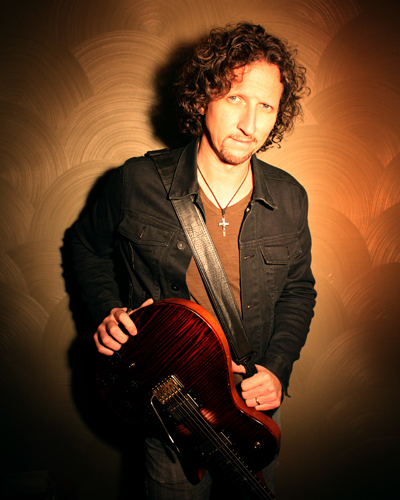
What was the key to bridging your guitar player and singer-songwriter sides for Disconnect?
Before Disconnect, I made some good records with some good songs. But there was always this vision of where I really wanted to go and I hadn’t managed to get there previously. After years of working on several records, things started to happen naturally. The progression wasn’t something I could force to happen. Also, after playing with Fish, things really started coming together for me as far as process. Fish gave me a lot of freedom as a guitar player. Steven Wilson was the same way. Even though Porcupine Tree appears to be a very structured thing, I was able to bring a lot of myself into the guitar role. I learned a lot from him, too.
Tell me about the themes the album’s title captures for you.
There are people that have had incredibly more difficult lives than I have, but I’ve had a rough time. When I was in Autodrive in the ‘80s, I got married at age 25 in the middle of gigging six nights a week all over the country. We had a baby and my wife and I broke up, with the relationship not ending well. So, one day I woke up at age 26, divorced, with a baby. Everyone is telling me to quit playing guitar, get a house and a job, and take care of that kid. But I’m thinking “I can’t do anything but play guitar. This is how I live. This is what I wake up and breathe.” Autodrive ended shortly after that. I moved in with my sister and was raising my kid. A couple of years later I gained custody. That’s one of the reasons I never had a big career push in the ‘90s. I was raising a daughter on my own. I was single. I moved down the street from my parents to get help from them while I was trying to manage a career playing guitar, pay rent, and do the best I could for my kid. It was difficult. Eventually, I remarried and that was a positive change.
Some other good things happened, like becoming a part of Porcupine Tree. Fast forward to 2010, and after some really difficult touring with that band in territories like India and Australia, I started to get mentally and physically beat up. I was kind of losing my mind as the band wound down with its Royal Albert Hall gigs in October of that year. It was really weird. I stepped out into an incredibly uncertain future with the band going on hiatus. I suddenly found myself disconnecting from home. Disconnecting from Porcupine Tree. Disconnecting from music. Disconnecting from the music business. Disconnecting from life. As I mentioned, then my mom got sick. All of that made me kind of snap. And that’s where the album title came from.
At the same time, I was observing people around me going through similar things. I had some friends who did some horrible tours in Iraq. They would come home and they were different people. I watched them disconnect in a different way. It became a theme for me. So, when I was writing the lyrics, contemplating my own issues, I thought “Do I go home? Do I run away? You’re approaching 50 and having a child for the second time, when you already have a grandson.” So, Disconnect is a story going through all of those things that aren’t easy. My stories combine with the stories of the others in the lyrics of the record.
The album also explores the other side of the equation, too.
True, but I was never a “happy happy joy joy” guy who writes about hot girls, beer and cars. However, at the end of most of these tracks, there is hope. There is resolution which is about the realization that life is tough and we do disconnect sometimes. But life is all we have and we sometimes have to force our way through it. The lyrics for “Once a Warrior” are about a friend of mine looking back on his life. He seemed unbreakable and then he looked down the path of life he had to follow and realized that actually he’s not only breakable, but broken. The ray of hope comes out of the knowledge that we can figure things out. In “Mary Will,” the character in the song finally focuses on that one thing—a statue of Mary. There’s no-one else for him, but there’s that statue who will redeem him.
Elaborate on the spiritual perspective “Mary Will” reflects.
I was raised Catholic, went to Catholic school, and survived the Catholic experience. I now possess more Catholic guilt than the law allows. [laughs] The statue of Mary would intervene with the big guy. As I was touring around the world, I would see some lost soul staring at her. Once I observed someone talking to a statue. When my wife’s grandmother died, we inherited her statue of Mary. It sits in my front yard in front of a window. The song was written from the perspective of being down and out and even though no-one else could be depended on, you could always depend on Mary. Maybe you did something in your relationship and your partner won’t stand for you any longer, but maybe Mary will.
Are you still a practicing Catholic?
I’m a retired Roman Catholic or RRC. [laughs]
You still wear a cross, though.
I wear it for many reasons. It was made by my uncle when I was 16, so I’ve always had it since then. I had a Catholic belief system ingrained into me. It’s something I can’t ever get totally away from. But as I age and learn things about life and faith, I have to make it fit into a broader philosophy of life.
Describe the creative process behind the propulsive, mercurial title track.
It started as an acoustic track that I performed for a long time. My co-producer Dean Tidey, drummer Mark Prator and I experimented with grooves for it when making the album and I realized there were more possibilities for it. So, I put the acoustic down and changed the inversions of the chords. I knew the melody I was going to sing was based off a G minor section, so I focused on creating chord changes that would support it. I figured out a completely different rhythm part that worked on electric and would create more of a unique groove for the drums. There are elements of Porcupine Tree in the rhythms. I’ve played 450 shows with the band, so that influence is going to come through. Part of the creative process was paying attention to who I am, accepting it and going with it. Once I did that, the songs came out more naturally.
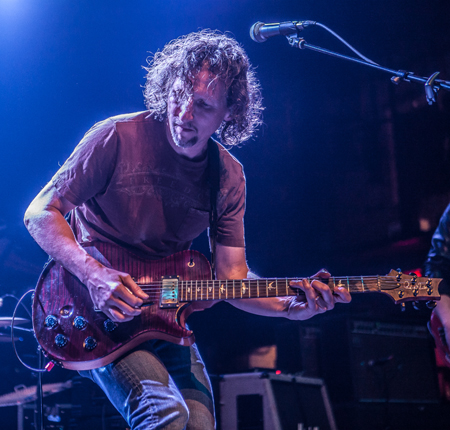
Delve deeper into what “Once a Warrior” is communicating.
I had a concept of soldiers when I was younger that when they came back from their glorious battles during World War II, Korea or Vietnam, they were these undefeatable people we should honor. I thought that because they had sacrificed so much, that the rest of their lives would be a cakewalk and that we’d always take care of them. As you grow up, you realize they come back to lives much harder than ours. Not only have they been through or experienced things they’ll carry with them the rest of their lives, so do the people around them. Then the reality of life back home kicks in. Not only does their sacrifice take a toll, but the carrying of that burden around does as well. That’s what the song deals with.
Does “How Goes the War?” conceptually link to that song?
It’s complex. A couple of guys I know that came back from overseas were people we lost for awhile. They would lose themselves playing video games, specifically World of Warcraft. They would spend large amounts of time in that world—like 11 hours straight without sleeping. They were disconnecting from life and human interaction. I remember walking in on someone playing the game one day and said “So, how goes the war, man?” That’s where it started. It’s also a metaphor for other things. You can apply “How Goes the War?” to anything. We all check out in certain ways. The song reflects that.
How did you get Alex Lifeson to contribute a solo to “Once a Warrior?”
He played on the Porcupine Tree track “Anesthetize” and I would cover his solo live. During the 2007 tour, we learned Alex was going to attend the Toronto show. So many of my formative guitar influences came from Rush records. I remember warming up before the show thinking “Oh my God, he’s going to watch me play and know I stole everything from him.” [laughs] But he was a lot of fun, gracious and we became friends. Once, at a subsequent Rush gig, he asked me what I was up to and I said “I’m finishing up Disconnect.” He said “Got any space left for me?” I looked at him and said “Why, yes I do.” [laughs] Dean and I then went back and created solo space in the track that would really allow Alex to breathe and do what he wants while still serving the song. I sent the piece to Alex with no instructions other than “Just play.” Two weeks later, he sent it back and I thought “Wow.” It was such an appropriate solo. He really listened to the song and you can hear its melodies reflected in his solo. He didn’t just blast something out over the chord changes. He created something that really fit.
Does Lifeson’s approach also reflect your own personal soloing philosophy?
Definitely. For me, guitar soloing is an extension of melodic, vocal ideas. I’ve always gravitated to players who did that, including Clapton, Gilmour and Hendrix. You’ll also hear it in guys like Warren Haynes and Derek Trucks too. How many Lifeson solos can most people sing in their head? Go to a Rush gig and tell me you don’t know all the licks before they happen. So, it’s less about chops and technique and more about a singing guitar approach, which you’ll hear me engaging in across the album.
You’re also very close to Neil Peart. How did that friendship emerge?
We have a mutual friend named Brian Catterson, who is very good friends with Neil’s riding buddy Michael Mosbach, who is also kind of his bodyguard. When they’re on tour, they ride together. Michael and Neil are also Porcupine Tree fans. I was in LA hanging out at GIT in 2007 taking some lessons and Brian was there and said “I’m going on a Sunday ride with Neil and Michael. Michael said I should invite you.” So, Brian, who was the editor of Cycle World at the time, had a stable of motorcycles and lent me one. So, I went riding with Brian, Neil and Michael. Neil’s a very cautious rider and observed me for a few hours. After that, he was very loose and we became friends. He said “We’ll ride again” afterwards and a couple of weeks later I got a call saying “Can you be in Oregon tomorrow?” I said “Why, yes, I can.” [laughs] And I flew out to Oregon. Michael had to go to LA to prep something for one of the Rush shows, so Neil and I rode for a couple of days through the mountains from Oregon all the way to LA. We really connected and he’s one of my dearest friends. Alex and I hit it off too. It all blows my mind sometimes.
Describe Dean Tidey’s role as a creative catalyst on the album.
Dean’s a very different guitarist than I am. So there wasn’t a lot of common ground. If I was playing one way, he would play the exact polar opposite. Being able to go back and forth between two different points of view really added a nice character to these compositions. Dean doesn't really like to solo at all. He’s all about textures and arrangements. He’s a very colorful player in terms of how he uses effects. I would play heavier, but I love effects too, coming from Porcupine Tree. I use everything on the boards. Our common ground focused on the textures and effects.
Dean brought in tons of experience from the people he worked with. He was able to bring the drums and guitars into a cohesive mindset. As we changed directions in the music, he could really help smooth those changes. Sometimes, I would keep hearing the guitars going different places and he was pretty good at reeling me in and not letting it go into the realm of self-indulgence.
Take me through the guitars you focused on for the album.
My main guitar is a custom PRS Singlecut from the Artist Shop. Winn Krozack from PRS pulled together a design in 2008 with LR Baggs that incorporated a Piezo pickup into the bridge of a Trem unit. He had the prototype sitting on his desk as R&D and at that point had not quite figured out how to put the electronics into a solid body without removing too much wood. In Porcupine Tree, I was using a couple of McCarty Archtop Piezo guitars on tour and I was really in need of a solid body Trem. I also asked PRS to make the finish satin, yet similar to a ‘50s-style guitar as I love that feel. It has 57/08 pickups and the Piezo Trem became the prototype for the P22 Trem they recently introduced.
On the album, I really go for a palette of tones. I have a ‘71 Telecaster with Joe Barden pickups that is also on almost every track. Combining a Tele tone with the PRS can make a part cut through. I used a Gretch White Falcon quite a bit, too.
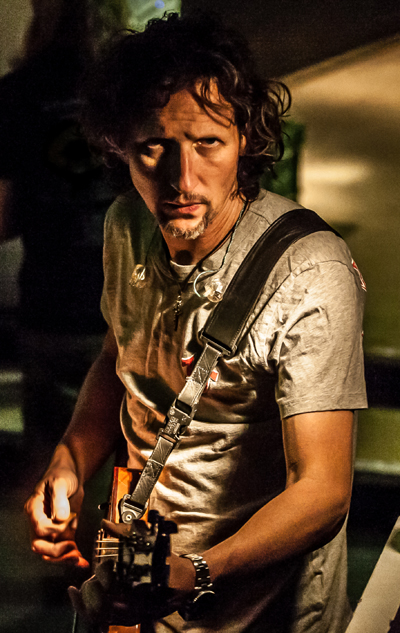
Describe your amp and mic universe.
I have two mid-‘70s JMP 120 Cameron Modded Marshalls. I have one in orange that’s all heavy tones. It’s a very “gain-y” amp. The black one was modified to have three channels: a Plexi channel, a JMP-style channel and a “Jose Mod,” Van Halen-esque channel. I pretty much hang with the first two as the Plexi Channel is voiced beautifully and the JMP channel is so versatile that I’ve never needed to go for the third channel. For some of the clean stuff, we also used a DR Z Maz SR 38 for “chime” kinds of tones. These amps also have a tube-buffered effects loop that I use for delays and reverbs.
My mic method is very old school. Jim Morris of Morrisound taught me to use a Sennheiser 421 and a Shure SM57 on the same speaker. I put the SM57 near or on the dust cover and the 421 on the same axis a little bit more into the cone. I buss them into separate busses and then combine them down to a single track. Instead of using any EQ in the tracking process, I raise or lower the input of each mic depending on what tone I feel needs to be added or subtracted. The SM57 brings the “rip” and the 421 delivers the “guts.” A crucial part of the signal chain is the mic pre. I use Vintech X73 mic pres. They are very Neve-like and color the sound that way.
You refer to your effects rig as a “Pandora’s box.” What’s inside it?
The GigRig G2 Switching System is the heart of the rig. It powers everything and keeps all my pedals out of line until needed. It enables me to control my Piezo, effects loop and channel switching. My effects chain is based around a kind of holy grail set of drive pedals. I’ve got a Klon Centaur and the Analogman King of Tone. My main delay is the Diamond Memory Lane 2. I use it in the effects loop for solos and that thick analog “color” delay. I have a some Fulltone Pedals, including the Deja Vibe, Chorus Flange and Wah. Sometimes, I use the Analogman Mini Bi-Chorus. There’s also the Electro-Harmonix Micro Pog and Bass MicroSynth, which created a few of the more outside sounds on the album. The Strymon Timeline Delay, BigSky Reverb, Lex Rotary, Mobius Modulation Effects, and El Capistan dTape Echo delay pedals are other favorites all over Disconnect too.
Reflect on your time in Porcupine Tree and what that experience meant to you.
Steven needed someone to help interpret his vision. When I came into it, Steven said “We’ve signed to a major label and we’re about to mix In Absentia. On one of the songs, the guitar didn’t come out the way I wanted it to. Can you make it heavier-sounding?” When I was playing with Fish, Steven would come see the band. I brought a heavier element to Fish’s sound that he didn’t have up until that point. I was rocking Les Pauls through Marshalls on stage. So, when Steven contacted me, he said “Can you bring some of that into 'Blackest Eyes?'" I said “Okay” and he sent me the Pro Tools tracks. I sent him eight tracks of Les Paul and Marshall, chugging that “Blackest Eyes” riff. Then he asked me to do a bunch of background vocals. Then Steven said “This record’s got more guitar and vocals on it than ever before. I could really use someone to pick up what I can’t cover on guitar and vocals live.”
A lot of people have said “Why didn’t you ever become a real member of the band?” I said “Well, I’m a live member. Steven doesn’t need any creative input from me. What he needs is someone to interpret his creativity and bring it to life.” That was my role in the band. I’d never go to Steven and say “Hey dude, I think we need to do this here.” It was more based on dialog like “Is there a sound or something we can do to make this work better live?”
I grew in a major way as a musician during my 10 years with Porcupine Tree. Performing with players like those makes you want to play as well as you can. Gavin Harrison is one of the most consummate musicians you’ll ever meet in your life. He’s always seeking new ideas, as is Steven. The experience really helped me evolve and take things to the next level in terms of my own creativity and output.
Another major career break for you was getting to open for Marillion in 1992. What are your thoughts about that period?
It was tough, because Marillion audiences are very discerning. During my first three shows with them, I was working as a tech so I could pay my bills. After that, I ended up as the opening act. Three opening acts didn’t go down well prior to that. One of them had the audience throwing coins at them in Toronto. This was at the beginning of the Holidays in Eden tour. So, I ended up getting the opening act slot. I realized I had to bring my A game every night and be sincere with the music. There had to be something real and substantive when playing those shows. I had to bring it because the audience wasn’t going to let me off the hook.
Very early on, Marillion recognized that I was a musician. I was just faking the tech thing. God bless Steve Rothery for allowing me to continue that illusion because he allowed me to do both. I was a guitar tech to pay my way, and then I’d change my clothes and go out and be the support act. I wasn’t a very good guitar tech at all. [laughs] I was good enough. The show went off every night, the gear got packed, nothing got broken, and everything was in tune. We had a lot of fun and it worked for them and me.
You went on to record your 1994 Under the Red and White Sky album with Marillion contributing to it. How do you look back at it?
That album opened up so many doors. It also led to me meeting Fish, which then resulted in meeting Steven Wilson. Steven had a saying that I was fond of, which is “None of arrive fully-formed.” That album was the first time I created something without being part of a band. It was all my thing and I wasn’t sure what I was doing. I wasn’t sure where I was musically. Again, I was trying to combine the guitar side with the singer-songwriter side to make something cohesive. It was the first step in that journey. There are some great lyrics on the album. I think I had dialed it in, lyrically, on earlier work. The album was the first release on Marillion’s Racket Records label and I thought it would sell a few hundred copies. It went on to sell thousands.
Tell me about your days working with Fish on the 1999 Raingods with Zippos tour and 2001’s Fellini Days album.
At one point during the making of Raingods with Zippos, Fish ended up without a guitarist. His producer recommended me as a replacement. Fish asked the Marillion guys and they recommended me as well. So, I went on to tour with Fish on the Raingods with Zippos tour. At the end of that, Fish said “I want to write a new record. Why don’t you come to Scotland? We’ll work there for a few months, do a few gigs and make the album.”
I spent four months at Fish’s studio every day writing and recording, which was very interesting. At the end of the Raingods with Zippos album, he had sold all the equipment and I walked into an empty studio. There was no recording gear. Fish managed to secure a little deal with Behringer, so we got a little mixing board from them. We started off that record tracking everything to MiniDisc. Then I convinced him to buy the consumer version of Pro Tools called Digi 001. So, we did the entire Fellini Days record through consumer software. It was the very first consumer Pro Tools rig that was released and it sounds like it. [laughs] I do think there’s some good stuff on the record. We did the best we had with the tools we worked with. There were some good ideas developing and had we had access to a real studio, the end result of Fellini Days would have been much better. But we didn’t.
You chose to give away your earlier material in order to create interest in your newer work. How has that strategy worked out?
During the first years of my solo career, people were either paying $35 to buy my albums as imports from a British label or weren’t buying them at all. I read how file sharing had ruined everything, so why not take what I had, let people hear it, and make believers out of them? I don’t believe musicians play for fans anymore. They play for believers. There are casual listeners who might buy a ticket or listen to you on Spotify, but you’ll never know them. Believers will go one step beyond and support what you do. With Disconnect, I didn’t make any conscious decisions to change the music to cater to an audience or adhere to rules in the book of songwriting. It’s an album for the believers—the people who still really care about music.
Alex Lifeson on John Wesley
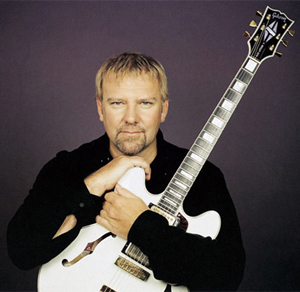
What made you want to contribute to Disconnect?
I could tell we shared the same discipline in our guitar playing in terms of context and content, evident throughout Wes’ songs on the album. The dynamics employed in his songwriting, and the strong vocal and guitar performances on every track make Disconnect cohesive and meaty. It was a privilege to be a part of this project.
How did you record your solo for “Once a Warrior?”
Wes provided stems but I found the supplied stereo main mix great to track to. I created a session in Logic Pro X and opened five tracks to record solo passes to, utilizing Guitar Rig 5’s 004–94 Rock Solo preset, with a touch of the overdrive pulled down. I recorded five passes from beginning to end, most starting essentially the same for the first four bars then taking off in different dynamic directions. I created a comp from those five takes and that’s what you hear.
What guitar did you use?
I recently had my Hentor Sportscaster refurbished by Freddy Gabrsek at Freddy’s Frets after about 20 years of inactivity. This session was the first project I did after its overhaul. It’s always been an inspiration to play and felt perfect for this piece.
Dean Tidey on making Disconnect
What inspired you to co-produce Wesley?
Wes and I were introduced by a mutual friend. We hit it off, as we’d had a lot of the same touring experiences and share a similar sense of humor. I hadn’t been in Tampa long and after being on tour all year with Feeder, I was looking for a project. We decided to do some co-writing together, which I don’t think Wes had done before. He’d always written on his own. The ideas came quickly and Wes was up for trying something new and I had a pretty good idea of how I thought we could sound. We got into the studio, with Mark Prator on drums, to start working through the new songs and the sound with our two guitars came together pretty quickly. I love working on parts and arrangements and I think Wes appreciated another opinion.
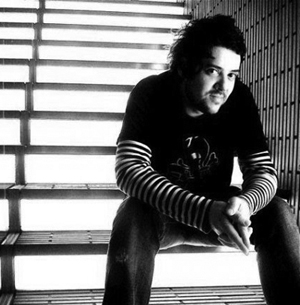
What was your key focus as co-producer?
I wanted to help in making the song the priority and for the album to be cohesive. I really wanted to push Wes, not just with his guitar playing, but with vocals and harmonies. I think I probably brought in a bit more of a pop sensibility.
Describe your approach when it came to recording guitars for the album.
My approach was to not be afraid to try anything and to have as much fun as we could with all the noise making machinery at our disposal. I also wanted to make sure that all of the guitars used were adding something. I didn’t feel that all the songs needed big solos. I think we ended up with a good balance. Wes did some great playing.
Tell me about the guitars you used on Disconnect.
The one thing we weren’t short of in the studio was guitars, amps and pedals. It looked a lot like an exotic guitar shop. Wes has some beautiful guitars, but I’m a lefty and although I’m not bad at playing upside down, I had to bring in some of mine. My main guitar for the last 15 years has been a Lefty Combat Jazzmaster that was made for me. It’s an incredible guitar and sounds amazing. I also used a Fender Strat Hendrix reissue, which is by far the best-sounding Strat that I have. In addition, you’ll hear a 1972 Fender Telecaster Deluxe, a Gretsch Tennessee Rose, and an Airline Folkstar on the album.
What are your favorite pieces on the album?
I like “Once A Warrior,” as it was the last thing that we worked on and we were writing it knowing that Alex Lifeson was putting a solo on it, which was just so cool. It was fun coming up with something for him to play over and I think it turned out really well. “Any Old Saint” was one of the first things that we wrote together, so I’m fond of that. I also really like “Window,” which is one of the straighter songs on the album. We had a blast making Disconnect and I’m proud of the way it turned out.